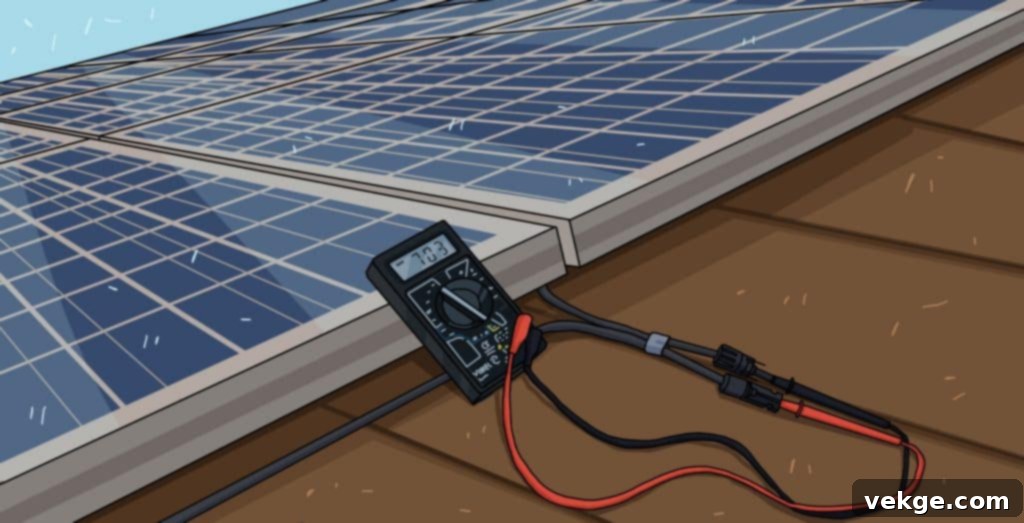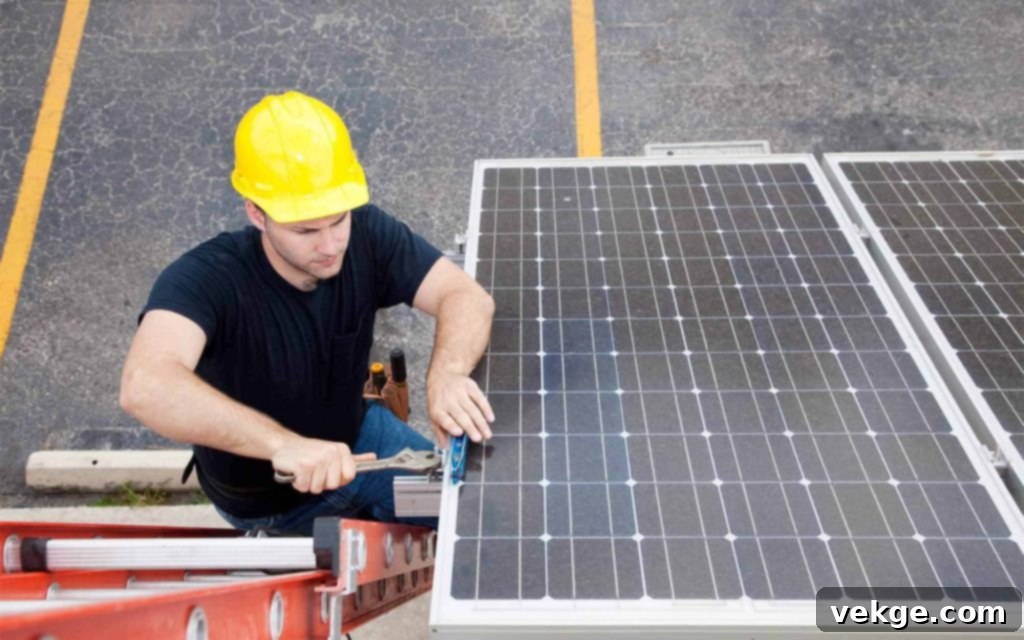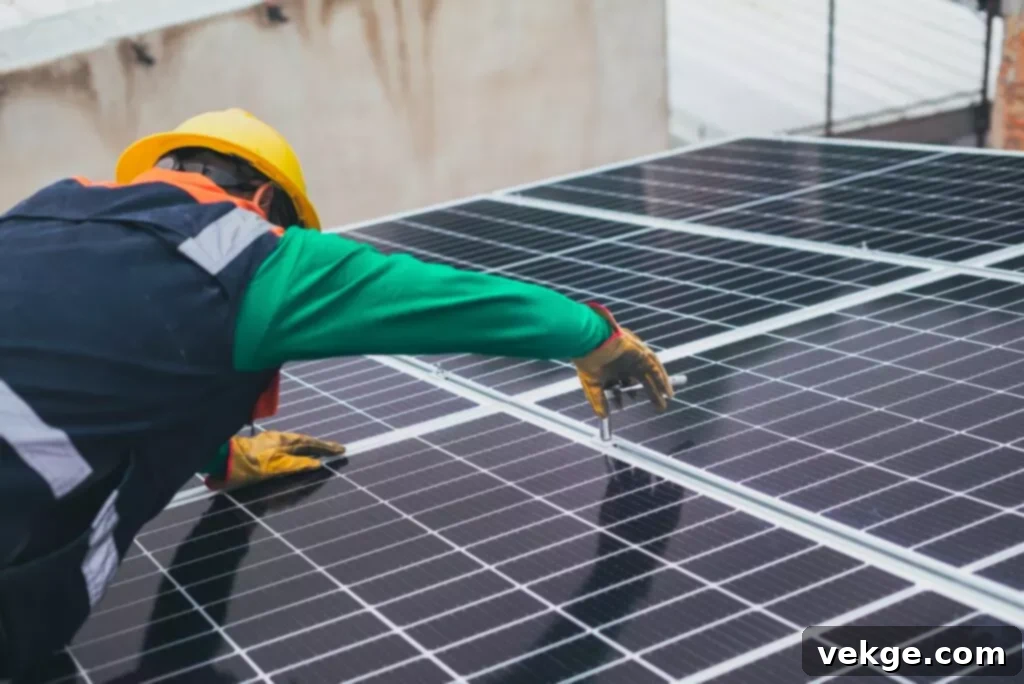Expert Guide: Identifying Signs Your Solar Panels Need Repair & Ensuring Peak Performance
Solar panels represent a significant and smart investment towards a sustainable future, becoming an increasingly popular feature on homes worldwide. Like any sophisticated technology, these systems demand attention and occasional maintenance to uphold their optimal performance and longevity. Proactively identifying issues early on is paramount; it not only extends the operational life of your entire solar energy system but also rigorously safeguards its efficiency and your financial return.
Understanding the clear indicators that your solar panels might require professional repair is crucial. These signs can stem from a variety of sources, including harsh weather damage, the natural aging process of components, or unforeseen technical failures within the system. Ignoring these warnings can lead to a gradual, or sometimes sudden, decline in energy production, ultimately impacting your electricity savings and the environmental benefits you sought to achieve.
Have you recently observed an unexpected spike in your monthly electricity bills? Or perhaps your solar energy system is simply not generating the amount of power it used to? These are often the first and most noticeable red flags. Beyond financial indicators, tangible signs such as visible discolouration, cracking, or other physical damage to the panels themselves, or even persistent alerts from your inverter, are definitive telltale signs that something is amiss and requires immediate investigation. Regular, proactive checks on your system’s energy output, ideally through dedicated monitoring software, can help identify more subtle underlying problems. These might include new shading or obstructions that weren’t present during the initial installation, or even less obvious issues related to the intricate wiring and connections within the system. Staying informed and vigilant about your solar panel system’s health allows you to address repair needs promptly, ensuring that the sun’s abundant power continues to flow efficiently and effectively into your home, maximizing both your savings and environmental contribution.
Common Signs of Solar Panel Issues: Don’t Ignore the Red Flags

Maintaining a watchful eye on the health of your solar panels is not merely good practice; it’s absolutely crucial for maximizing your return on investment and ensuring a consistent energy supply. Recognizing the earliest signs of trouble can be the difference between a minor repair and a costly system overhaul or premature replacement. Here’s how to identify common issues:
1. Visual Inspections: What to Look For on Your Panels
A simple visual inspection, performed safely from the ground or by a professional, can reveal a great deal about the condition of your solar panels. When examining your panels, pay close attention to the following:
- Cracks and Breakages: Visible cracks in the glass surface or damage to the panel frame can compromise the panel’s integrity and expose internal components to moisture. These can be caused by severe weather like hail, falling debris, or even improper installation.
- Discolouration and “Snail Trails”: Panels might develop noticeable yellowing, browning, or even dark “snail trails” across their surface. This often indicates delamination (separation of layers), moisture ingress, or degradation of the EVA encapsulant, which can severely impact performance.
- Hot Spots: While not always visible to the naked eye, “hot spots” are localized areas of overheating on a panel. These can sometimes manifest as scorched marks over time. They are typically caused by faulty cells, partial shading, or dirt accumulation and can significantly reduce output and pose a fire risk.
- Dirt, Debris, and Obstructions: An accumulation of heavy dirt, dust, bird droppings, leaves, or other debris can obstruct sunlight and directly reduce efficiency. While regular cleaning can address this, persistent or heavy build-up may require more frequent attention. Also, check for new shading sources, such as growing trees or new constructions, which can significantly impact energy production.
- Loose or Damaged Wiring: Inspect visible wiring for any signs of fraying, cracking insulation, or loose connections. Damaged wiring can lead to energy loss, system malfunctions, or even electrical hazards.
- Pest Damage: Animals like rodents or birds can nest under or around panels, chewing through wires or creating blockages. Look for signs of nests or droppings.
Even small blemishes or seemingly minor physical damage should not be ignored, as they can quickly escalate into bigger, more expensive issues if left unaddressed. Always exercise caution and prioritize safety when attempting any visual inspection; never climb onto your roof without proper safety equipment and training.
2. Performance Checks: Monitoring Your Energy Output
A sudden or gradual drop in energy production is one of the most reliable indicators of a problem. Your solar system should consistently produce energy based on seasonal sunlight availability. Here’s how to monitor it:
- Review Electricity Bills: If you notice an unexplained spike in your electricity consumption or a decrease in your net metering credits, it’s a strong sign your solar system isn’t pulling its weight. Compare current performance data with past records to spot significant deviations.
- Utilize Monitoring Software: Most modern solar panel systems come equipped with monitoring software or apps. These tools provide real-time data on your system’s energy production (in kWh or kW), inverter status, and sometimes even individual panel performance. Regularly checking this data for inconsistencies against expected output (considering weather conditions) is crucial. A sudden dip in production for an entire string of panels or the whole system points to a likely issue.
- Inverter Readings: Your inverter is the heart of your solar system, converting DC power from the panels into AC power for your home. Check its display for any error codes or unusual readings. Some inverters have indicator lights that signal normal operation or a fault.
If the decline in energy production is consistent and cannot be explained by weather patterns (e.g., prolonged cloudy periods), it’s a strong hint that your panels or an associated component might need a professional diagnosis.
3. Monitoring System Alerts: Heeding Automated Warnings
Many advanced solar panel systems are equipped with sophisticated monitoring software designed to alert you if there’s a problem. These systems are invaluable for proactive maintenance:
- Warning Messages & Fault Notifications: Do not ignore any warning messages, fault notifications, or error codes generated by your solar monitoring system or inverter. These alerts are specifically designed to highlight anomalies or failures within the system.
- Types of Alerts: Common alerts include “inverter fault,” “grid disconnection,” “low production,” “communication error,” or specific component failures. Understanding what these messages mean (often explained in your system’s manual or by your installer) can help you quickly assess the severity and necessary response.
- Prompt Action: These monitoring systems are your first line of defense, providing immediate insights into your solar panel’s health. Acting promptly when they signal for help can prevent minor issues from escalating into major system breakdowns, saving you time and money in the long run.
Professional Assessment and Repairs: When to Call the Experts

When you encounter any of the aforementioned signs of trouble with your solar panels, seeking professional assistance is not just recommended, it’s often essential. Certified technicians possess the specialized knowledge, tools, and experience required to accurately diagnose complex issues and implement effective resolutions, ensuring your solar energy system operates at its maximum potential and safely.
Hiring Qualified Technicians: What to Look For
Entrusting your valuable solar panels to the right professionals is paramount for a thorough, safe, and effective repair process. When selecting a solar technician or company, consider these vital qualifications:
- Certification and Licensing: Ensure technicians are certified by recognized industry organizations (e.g., NABCEP in North America) and the company holds all necessary local and state licenses. This guarantees they meet professional standards and are qualified to perform solar electrical work.
- Experience and Specialization: Look for professionals with a proven track record specifically in solar panel diagnostics and repairs. Ask about their experience with your specific brand or type of solar equipment.
- Comprehensive Insurance: Always choose technicians and companies that carry adequate liability insurance. This protects you from financial responsibility in case of accidental damage to your property or injury to the workers during the repair process.
- Reputation and References: Check online reviews, testimonials, and ask for references from previous clients. A reputable company will have positive feedback and be transparent about their work.
- Warranty on Work: Inquire about warranties on their repair work and any replaced components. A good company stands behind its service.
Professional diagnostic tools include thermal imaging cameras (to detect hot spots), IV curve tracers (to analyze electrical performance), insulation resistance testers, and specialized voltage/current meters. These tools allow technicians to pinpoint problems that are invisible to the naked eye or that standard monitoring systems might not detect.
Repair or Replace: Making the Right Decision
The choice between repairing a faulty component and opting for a full replacement can be complex, involving both economic and practical considerations. Here are the key factors to weigh:
- Age of Solar Panels and System: If your solar panels or key components like the inverter are nearing the end of their projected lifespan (typically 20-25 years for panels, 10-15 years for inverters), replacement might be a more cost-effective long-term solution. Newer technology often offers improved efficiency and performance, making an upgrade worthwhile.
- Extent and Nature of Damage: Minor issues, such as a loose connection, a single faulty bypass diode, or a small crack in the glass that hasn’t compromised internal cells, often warrant repairs. However, significant damage like widespread delamination, multiple broken cells, or a severely damaged inverter might necessitate total replacement, especially if the repair cost approaches the cost of a new unit.
- Warranty Status: Crucially, check the warranty status of your panels and inverter. Most solar panels come with a 20-25 year performance warranty and a 10-12 year product warranty. Inverters typically have a 10-year warranty, often extendable. If your panels or components are still under warranty, you may be eligible for free or discounted repairs or replacements, significantly reducing your out-of-pocket expenses. Ensure you understand the terms and conditions of your warranty.
- Cost-Benefit Analysis: A qualified technician can help you perform a cost-benefit analysis, comparing the cost of repair with the cost of replacement, factoring in potential downtime, future reliability, and efficiency gains from new equipment.
The Benefits of Proactive Maintenance and Timely Repairs
Investing in your home’s solar panels is a significant commitment. To truly maximize the return on this investment, proactive maintenance and timely repairs are indispensable:
- Sustained Energy Production: Regular checks and swift repairs ensure your system continues to produce power at its optimal capacity, keeping your electricity bills low and maximizing your energy independence.
- Extended System Lifespan: Addressing minor issues before they escalate can significantly prolong the overall life of your solar panel system, protecting your initial investment for decades.
- Financial Savings: Timely repairs are almost always less expensive than emergency replacements. By staying ahead of potential problems, you avoid costly downtime and major repair bills.
- Environmental Impact: A well-maintained and efficient solar system means a lower carbon footprint and a greater contribution to sustainable energy goals.
- Maintained Home Value: A functional and efficient solar energy system adds considerable value to your home. Regular maintenance ensures this asset remains in top condition.
To ensure you are getting the most out of your solar panels, keep a vigilant eye out for diminishing returns on your energy production. Perform periodic visual and performance checks on your panels, and, most importantly, engage a professional solar panel service at the first sign of trouble. This proactive approach ensures that any issues can be addressed promptly, and necessary repairs or replacements can be completed efficiently, keeping your solar panels operating at full capacity and delivering sustainable energy to your home for years to come.
